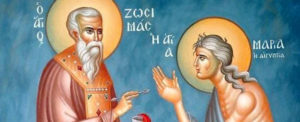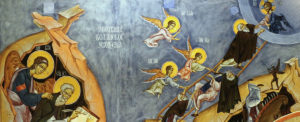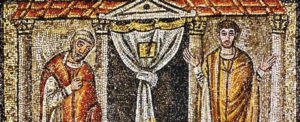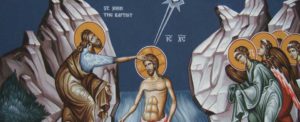The Transfiguration of Christ is one of the central events recorded in the Gospels. Immediately after the Lord was recognized by his apostles as “the Christ, the Son of the Living God,” he told them that “he must go up to Jerusalem and suffer many things … and be killed and on the third day be raised” (Mt 16). The announcement of Christ’s approaching passion and death was met with indignation by the disciples. Then the Lord took Peter, James, and John “up to a high mountain” — by tradition Mount Tabor — and revealed himself to them:
“Truly I tell you, some who are standing here will not taste death before they see the Son of Man coming in his kingdom.” Six days later, Jesus took with him Peter, James and John the brother of James, and led them up a high mountain by themselves. There he was transfigured before them and his face shone like the sun, and his garments became white as snow and behold, there appeared to them Moses and Elijah, talking with him. And Peter said to Jesus, “Lord, it is well that we are here; if you wish I will make three booths here, one for you and one for Moses and one for Elijah.” He was still speaking when a bright cloud overshadowed them, and a voice from the cloud said, “This is my Beloved Son, with whom I am well pleased; listen to him.” When the disciples heard this, they fell on their faces with awe. But Jesus came and touched them, saying, “Rise, and have no fear.” And when they lifted up their eyes, they saw no one but Jesus only. And as they were coming down the mountain, Jesus commanded them, “Tell no one the vision, until the Son of Man is raised from the dead” (Mt 16:28-17:9).
Peter later described this awesome experience:
For we did not follow cunningly devised fables when we made known to you the power and coming of our Lord Jesus Christ, but were eyewitnesses of his majesty. For he received from God the Father honor and glory when such a voice came to Him from the Excellent Glory: “This is My beloved Son, in whom I am well pleased.” And we heard this voice which came from heaven when we were with him on the holy mountain (2 Peter 1:16-18).
In the Transfiguration, the apostles see the glory of the Kingdom of God present in majesty in the person of Christ. They see that “in him all the fullness of God was pleased to dwell,” that “in him the whole fullness of deity dwells bodily” (Col 1:19, 2:9). They see this before the crucifixion, so that in the resurrection they might know who it is who has suffered for them, and what it is that this one, who is God, has prepared for those who love him. This is what the Church celebrates in the feast of the Transfiguration.
Troparion: Thou wast transfigured on the mountain, O Christ God, revealing Thy glory to Thy disciples as they could bear it. Let Thine everlasting light shine upon us sinners. Through the prayers of the Theotokos, O Giver of Light, glory to Thee.
Kontakion: On the mountain wast Thou transfigured, O Christ God, and Thy disciples beheld Thy glory as far as they could see it; so that when they would behold Thee crucified, they would understand that Thy suffering was voluntary, and would proclaim to the world that Thou art truly the Radiance of the Father.
Besides the fundamental meaning which the event of the Transfiguration has in the context of the life and mission of Christ, and in addition to the theme of the glory of God which is revealed in all of its divine splendor in the face of the Saviour, the presence of Moses and Elijah is also of great significance for the understanding and celebration of the feast. Many of the hymns refer to these two leading figures of the Old Covenant as do the three scripture readings of Vespers which tell of the manifestation of the glory of God to these holy men of old (Ex 24:12-18; 33:11-34:8; 1 Kings 19:3-16). Moses and Elijah, according to the hymns appointed for the feast, are not only the greatest figures of the Old Testament who now come to worship the Son of God in glory; they also are not merely two of the holy men to whom God has revealed himself in the prefigurative theophanies of the Old Covenant of Israel. These two figures actually stand for the Old Testament itself: Moses for the Law and Elijah for the Prophets. And Christ himself is the fulfillment of the Law and the Prophets (Mt 5:17). They also stand for the living and dead, for Moses died and his burial place is known, while Elijah was taken alive into heaven in order to appear again to announce the Day of the Lord. In appearing with Jesus on the mount of Transfiguration, Moses and Elijah bear witness that the Lord has come, and that he is the incarnate Son of God to whom the Father himself bears witness: the Lord of all creation, of the Old and New Testaments, of the living and the dead. The Transfiguration of Christ is the fulfillment of all of the Old Testament theophanies and manifestations of God, a fulfillment made perfect and complete in the person of Christ. The Transfiguration of Christ reveals to us our ultimate destiny as Christians, the ultimate destiny of all men and all creation to be transformed and glorified by the majestic splendor of God himself. The feast of the Transfiguration is celebrated on the sixth of August (Aug. 19 on the civil calendar). The summer celebration of the feast suits the theme of transfiguration. The blessing of grapes, as well as other fruits and vegetables on this day is the most beautiful and fitting sign of the final transfiguration of all things in Christ. It signifies the ultimate flowering and fruitfulness of all creation in the paradise of God’s unending Kingdom of Life where all will he transformed by the glory of the Lord.






